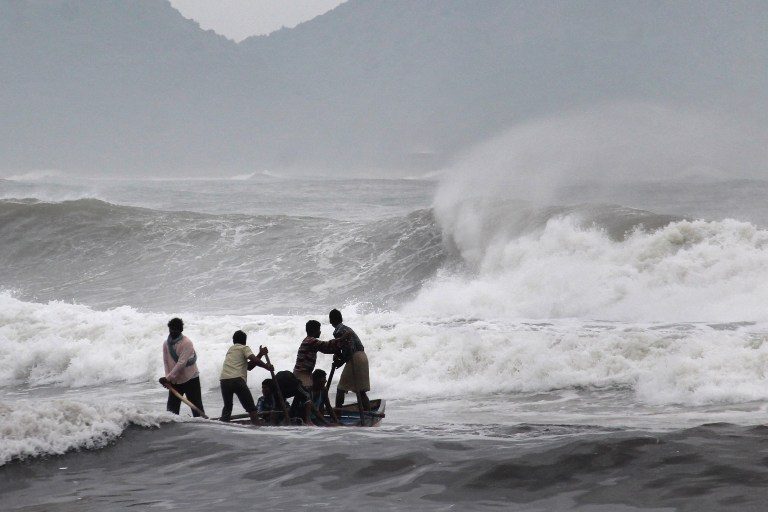SUMMARY
This is AI generated summarization, which may have errors. For context, always refer to the full article.

HYDERABAD, India – A major relief operation was under way Monday, October 13, after a cyclone pounded India’s eastern coast, killing at least 6 people and leaving a trail of destruction, but officials said mass evacuations helped avert a larger tragedy.
Most of the deaths were caused by falling trees and collapsed buildings in the southeastern state of Andhra Pradesh, which was worst hit by Cyclone Hudhud. A one-year-old child from the port city of Visakhapatnam was among the dead.
The storm struck just before midday on Sunday, October 12, bringing torrential rain and winds of nearly 200 kilometers (125 miles) an hour before weakening as it barreled inland.
Authorities in Andhra Pradesh and the neighboring state of Orissa evacuated around 350,000 people before the cyclone hit, in an attempt to avert the mass casualties inflicted on the area by previous cyclones.
“The government was able to reduce loss of life due to the precautionary measures taken,” Andhra Pradesh chief minister N. Chandrababu Naidu told the Press Trust of India (PTI).
P.K. Mohapatra, special relief commissioner of Orissa, told Agence France-Presse his state was “better prepared this time”, after Cyclone Phailin killed at least 18 people in the state last year.
“People followed our cyclone warning, there was hardly any traffic on the roads,” Mohapatra said.
In Visakhapatnam, which bore the brunt of the storm’s fury, homes had their roofs ripped off and hundreds of fallen trees and power pylons blocked roads.
Water and power supplies were cut off, and the city’s airport and railway lines were also badly damaged.
“There is no power, no water or milk, no electricity. We are not getting petrol. We cannot move on the roads. It is difficult to survive a single day here,” PTI quoted a resident as saying.
National Disaster Response Force teams began Monday to try to restore power to affected areas as evacuees left cyclone shelters and returned to their homes, the news agency said.
India’s Prime Minister Narendra Modi tweeted that he would visit Visakhapatnam on Tuesday, October 14.
India’s east coast and neighbouring Bangladesh are routinely hit by severe storms between April and November that cause deaths and widespread property damage.
Some of the deadliest storms in history have formed in the Bay of Bengal to India’s east, including one in 1970 that killed hundreds of thousands in what is now Bangladesh.
Last year India undertook its biggest-ever evacuation before the arrival of Cyclone Phailin, with about a million people moved from their homes along the east coast.
Mohapatra said an additional 230,000 people had been evacuated from areas at risk of flooding in Orissa by late Sunday.
“No one was killed in Orissa by Hudhud,” he told Agence France-Presse, although two children and a fisherman died on Saturday when their boat capsized during an evacuation.
Many evacuees returned on Monday to their homes along the eastern coast, which is mostly populated by fishermen and small farmers living in flimsy huts with thatched roofs or shanties. – Rappler.com
Add a comment
How does this make you feel?
There are no comments yet. Add your comment to start the conversation.